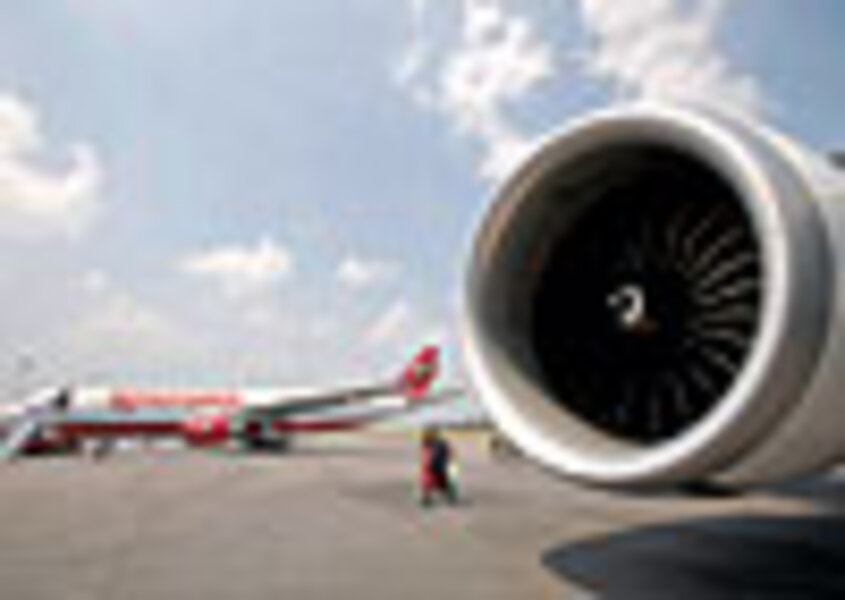After rapid climb, India's airlines face steep descent
Loading...
| NEW DELHI
"Fly the good times," urges the slogan of Kingfisher airlines, India's biggest carrier.
"But not the bad," it might have added earlier this month, when Kingfisher, along with six other private airlines, threatened a one-day strike to demand government help to save them from going bust.
Only two years ago, India's private airlines were held up as symbols of the country's spectacular economic growth. After the government opened commercial aviation to increased competition in 2004, half a dozen airlines were started to serve India's fast-growing and flush middle class.
Passenger numbers surged as cheap flights proved an irresistible alternative to long, bumpy train journeys.
Kingfisher, which is named after India's most popular brand of beer – the two share a founder – and its main rival, Jet Airways, led the boom. Travelers were amazed at the service they provided – roomy seats, hot towels, impeccably polite attendants, and three-course meals – at prices that were often cheaper than train fares.
Kingfisher and Jet quickly got involved in a race to become dominant international carriers and shelled out billions of dollars for planes suitable for long-haul journeys.
Those days are long gone.
In the quarter ending June 30, Kingfisher recorded a net loss of 2.43 billion rupees ($51 million) and Jet, a net loss of 2.25 billion rupees. Both are slashing long-distance flights, and the two rivals have plans to share airport facilities and coordinate schedules to cut costs.
Amid decline, a demand for lower taxes
India's airline boom began to fade in 2007, when a rise in fuel prices pushed up fares and lowered passenger numbers. The more recent economic slowdown has eaten further into air travel. From January to June this year, airline passenger numbers fell by 8 percent to 21.1 million. Last year, India's airlines sustained accumulated losses of $2.5 billion – 25 percent of airline losses worldwide, although India accounts for only 2 percent of the world's passengers.
Amid mounting losses, the airlines decided that lower jet-fuel taxes are the answer. But when lobbying didn't work, they threatened to go on strike. Though the proposed Aug. 18 work stoppage was put on hold after the government warned the airlines not to inconvenience passengers, the issue still looms. Vijay Mallya, Kingfisher's chairman, recently claimed that the airlines are being "taxed to death."
Certainly, India's high fuel costs exacerbate airlines' woes. India's jet-fuel tax averages about 26 percent, several times higher than the international average. The airlines want the fuel to be declared an essential commodity and taxed at a uniform 4 percent.
In mid-August civil aviation minister Praful Patel said that the central government would form a panel of ministers to tackle the problem of high jet-fuel prices. But a senior Indian official, who did not want to be named, said that was unlikely to happen anytime soon. Why? The tax is an important source of revenue for state governments struggling to keep their coffers full during the global recession. Analysts say fuel taxes, while burdensome, are not at the root of the airlines' troubles. The economic downturn is not to blame either. "The airlines were struggling before the slowdown," says Binit Somaia, Asia director of the Centre for Asia Pacific Aviation (CAPA).
He says the problem is simple overcapacity: India's ambitious, flashy airlines assumed the high growth of their early years in business would never cool off.
Cheap ticket prices, designed to win market share, were priced well below costs and were not sustainable. When prices went up, passengers fell away. "You can get anyone to fly for 500 rupees [$10]," says Mr. Somaia.
The plane-shopping sprees didn't appear to consider that higher prices would cut demand, and some analysts say that the airlines bought twice as many aircraft as were needed. The overheated situation was a boon to pilots and mechanics, who were constantly being poached and pursued. Staff costs soared.
"It was all about ego rather than business," says C. Gopinath, founder of low-cost airline Deccan. "The whole culture of it was wrong. Airlines needed to be more like Ryanair [the Irish no-frills carrier]; instead, they stood on pride."
Budget airlines rise
Not anymore. In line with a global trend toward business passengers cutting their travel costs by flying with budget carriers, India's no-frills airlines are taking a bigger slice of the market. Of India's three publicly traded airlines, budget carrier Spicejet was the only one to turn a profit in the quarter ending June 30; the other two are Kingfisher and Jet.
Today, Kingfisher and Jet are scaling back their full-service flights. Jet has launched a budget line called Jet Konnect, while Kingfisher has transferred many of its flights to its budget subsidiary, Kingfisher Red. The luxury treatment is gone except for those lucky passengers with the cash to pay for it. The breathless expectations of world domination are gone.
Instead, India's airlines are now aiming for the really big opportunity that's been in front of them all along: the 98 percent of Indians who have still never flown.





